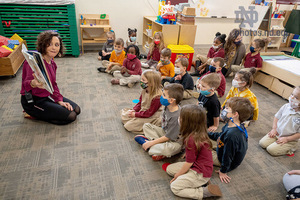 "
"
Most Notre Dame students asked about learning during the pandemic will conjure up memories of the HERE campaign. Maybe what comes to mind for you is competing for a quiet spot in a hectic household, or logging into Zoom classes from a locked South Bend hotel room. Maybe you remember the green signage dotting the quads or the apocalyptic feeling of stopping for a nasal swab en route to a final exam.
During the height of COVID, the Notre Dame bubble was less permeable than usual. But taking a journalism class during the spring of my senior year and reporting on local public schools gave me a glimpse into South Bend students’ experiences of pandemic learning. In Prof. Brendan O’Shaughnessy’s investigative reporting class last spring, my classmate Chloe Stafford ’23 and I reported on trends of chronic absenteeism in the city of South Bend. What we found were K-12 schools entirely changed by the pandemic, with students and adults struggling to reconnect after more than a year of distance learning.
The numbers by themselves told a dramatic story. Chloe and I learned that more than half of South Bend’s public school students were chronically absent — missing at least 10% of their class days — and that the return to in-person classes hadn’t solved the problem. But over the course of the semester, reporting on the issue gave us a perspective that the statistics alone could not. Systemic inequities are a major issue in South Bend, and they’ve made getting to class difficult for many students long before the start of COVID. Those inequalities need to be confronted. But across the board, interviewees told us that social learning and chances to be with friends are a big piece of the equation, too.
Looking back on the story, what’s stuck with me are the anecdotes of how children’s social lives changed. Parents described their kids longing for less-restricted time with friends, and teachers spoke about the soaring demand for extracurriculars. Young children growing up amid COVID restrictions didn’t get the chance to play on grade-school basketball teams or go to middle school dances or even sit with their friends in class. Of course going to school lost its luster.
Talking with educational experts during our reporting helped reframe our questions about how schools and students were impacted by the pandemic. Chronic absenteeism is a symptom of a bigger problem: For many students, school doesn’t make them want to come and learn every day. To solve the issue of missing students, schools need to make them excited to show up.
Right now, K-12 public schools across the country are under the strain of teacher shortages,curriculum culture wars and COVID-era learning loss. All those issues matter, but above all,
students should be passionate about learning. To confront the host of post-pandemic challenges, schools need to figure out what makes children excited to come to school. And schools need to ensure that students — and teachers, for that matter — are getting the tools they need to grow and thrive, from mental healthcare and free meals to relevant classes and cultural clubs.
We began our reporting efforts wondering why South Bend students were absent at such high rates. We ended with a more complex understanding of what students need and what they’ve been missing since schools shut down in March of 2020. Reporting on South Bend schools gave me a new perspective on what learning has been like since the start of the pandemic. It helped me appreciate the myriad of challenges that teachers are confronting right now. And it showed me that understanding K-12 education is a window into understanding what issues Americans care about most.
Journalism has the power to help us look outside ourselves, disrupting our assumptions about the world and about each other. While Notre Dame students confronted HERE regulations and a rocky return to in-person classes, South Bend’s students faced parallel challenges. Without exception, COVID changed what school is like for students from kindergarten through college. Reporting this piece invited me to deepen my curiosity about the South Bend communities we neighbor — and about all the stories from the pandemic that can change how we think about learning